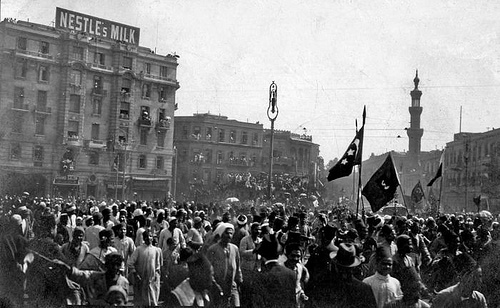https://egyptmanchester.wordpress.com/2019/04/08/the-egyptian-revolt-of-1919-its-aftermath/
The Egyptian Revolt of 1919 & its aftermath
Museum Studies placement student William Pridden considers the significance of a recently acquired historic photograph in light of the 200 year anniversary of the Peterloo Massacre, and the centenary of both the 1919 Jallianwalla Bagh Massacre and the rather less well-known 1919 revolts against British rule in Egypt.
An artefact can tell many stories. The truth of this statement grew clearer each day as I began researching a surprising photograph found in a gallery, among other assorted artefacts, from Luxor, Egypt. The photograph depicts the King of Egypt and Egyptian officials in the company of British dignitaries. What at first appeared to be a simple photo of a King visiting a foreign country soon turned into a narrative of freedom, oppression and violence: entwining the sovereignty of Egypt with the city of Manchester.

King Fuad of Egypt with Mohamed Shaheen Pasha, private physician to the king; Amin Auis Pasha, Vice director of the royal cabinet; Ahmed Mohammad Hassanein Bey, first chamberlain; Achille Sekaly Bey; lieutenant colonel Khairy Bey, Aide-de-camp and M. Illias Ismail, Egyptian consul at Liverpool. Manchester officials: Lord Mayor, James Henry Swales; Lady Mayoress; Mr. Heath, Town Clerk; Alderman Miles Mitchel, Deputy Mayor; Aldermen T. Fox, Derwent Simpson and Robert Turner. 1927.
The photograph was taken during King Fuad's visit to Manchester in 1927, during which time Egypt was still under occupation by the British Military despite having secured official 'Independence' in 1922. The King's visit was in celebration of the area's long history in the cotton industry as Egypt provided the vast bulk of cotton supplies to the North West at this time. However, King Fuad's message to the Mayor of Manchester arguably alludes to the true intention of his trip: to highlight Egypt's long struggle for self-determination. King Fuad highlighted the importance of the Egyptian people in the growing of the cotton industry, describing the River Nile as being the lifeblood of his countrymen. The King also drew similarities between the civic governors of Manchester and Egypt in regards to their faith and character. The speech appeared to emphasise Egypt's reliability as an independent nation and assured the British people of a continuing collaboration, finally stating that Egypt had "no truer friend or more sympathetic watcher" than the British Empire.

Protesters against British rule, Cairo 1919
The British newspapers spoke of the crowds cheering for King Fuad, of the sun shining down on the city, of the King saluting the Cenotaph to applause: no mention was made of the Egyptian Revolution in 1919. From March to July it is estimated that 800 Egyptian civilians were killed throughout the country with a further 39 sentenced to death by the British Empire. Those who were not killed were arrested with over 2,000 people jailed as a result of civil unrest. The revolution was an act of unity among the entire Egyptian populous with women and men, poor and rich, attempting to free the country from colonial rule.

Egyptian women protest, 1919
The 1919 Revolution marks a continuing narrative of oppression not usually discussed in the British Media. As the centenary of the Jallianwala Bagh Massacre approaches (in which 1,600 Indians lost their lives) it is important to remember the harsh reality of colonial rule. The events of the Egyptian Revolution and the Jallianwala Bagh Massacre are not independent of each other, but instead are part of a shared universal history among former colonial countries and deserve to be remembered: rather than being forgotten due to shame. The photo of King Fuad's visit represents a struggle for freedom and the chance to make amends. By remembering these colonial transgressions, a greater dialogue on tolerance can be learnt.
– William Pridden is a Museum Studies student at the University of Durham. The photograph (accession number 14088) was purchased in Luxor and kindly donated by Tom Hardwick in honour of my predecessor as Curator of Egyptology, Christina Riggs.
Our new exhibition Jallianwala Bagh 1919: Punjab Under Seige opens this week. The 1927 photograph will be on display in our third floor space later this month.
-- Sent from my Linux system.
No comments:
Post a Comment